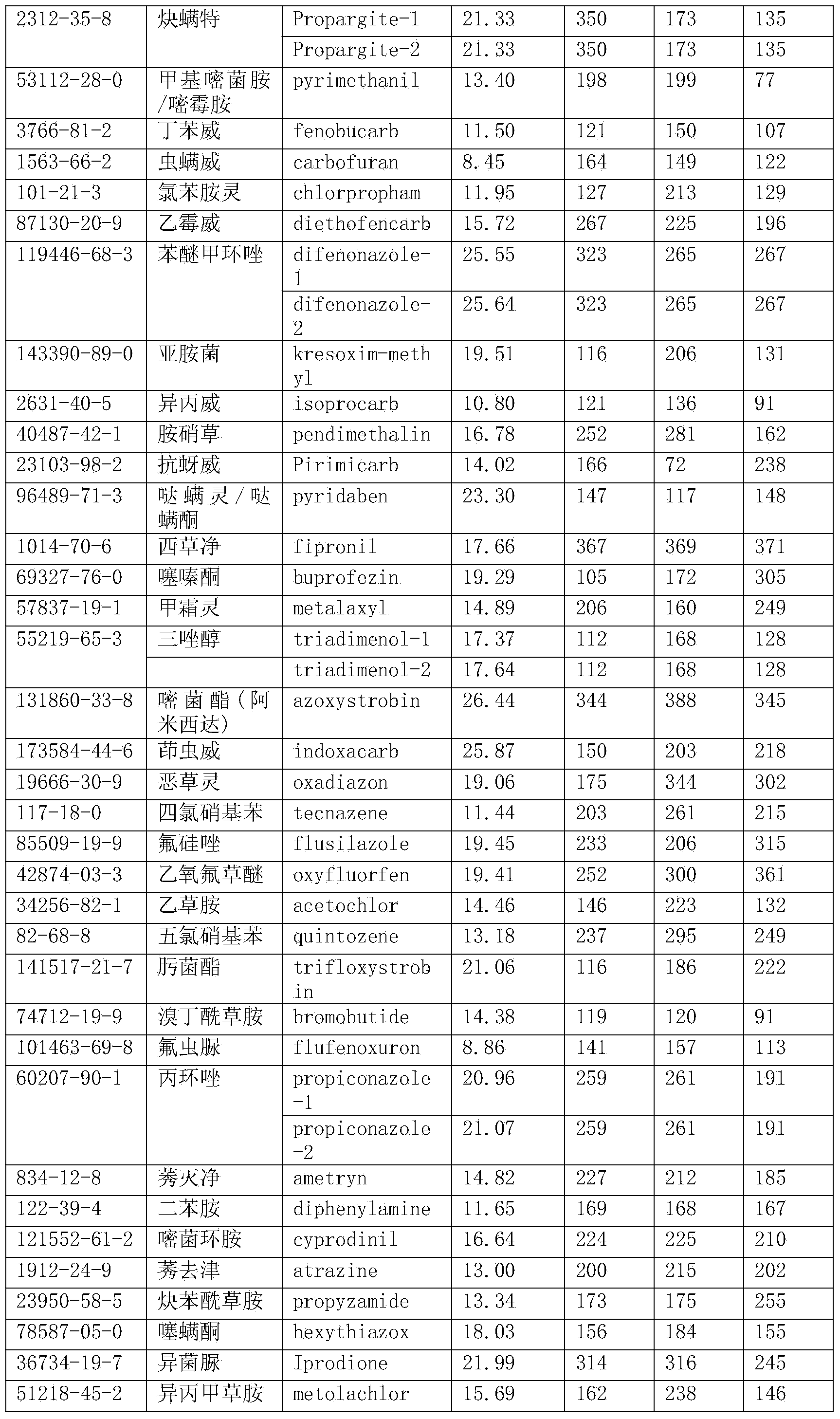Method for detecting pesticide residues in tea by using gas chromatograph-mass spectrometry
A technology of pesticide residues and combined technology, which is applied in the direction of measuring devices, instruments, scientific instruments, etc., can solve the problems of few types of pesticide residues and inaccurate pesticide residues, and achieve good purification effect
- Summary
- Abstract
- Description
- Claims
- Application Information
AI Technical Summary
Problems solved by technology
Method used
Image
Examples
specific Embodiment approach
[0021] (1) Configure standard stock solution:
[0022] Accurately weigh about 0.0100g of standard substance of each pesticide, add it into a 10mL volumetric flask, dissolve with acetone and adjust the volume to the mark, and prepare a standard stock solution with a concentration of 1000mg / L of each pesticide, and refrigerate for later use.
[0023] (2) Configure mixed standard working solution:
[0024] The standard stock solution of each pesticide was taken out and placed in a 100mL volumetric flask to prepare a mixed standard working solution with a concentration of 10mg / L, and refrigerated for later use. The period of use is 1 month.
[0025] (3) Set instrument parameters:
[0026] Gas phase-mass spectrometer matching autosampler parameter settings are as follows: Shimadzu AOC-20i+S, inlet temperature 250.0°C, injection volume 1uL, splitless injection; carrier gas: high-purity helium , initial pressure 500-900Pa, linear velocity 36.8cm / sec, purge volume 6.0mL / min; capill...
Embodiment 1
[0049] Experimental materials: Standard pesticide residues were purchased from DrEhrenstorfer GmbH. Acetone, n-hexane, acetonitrile and ethyl acetate used for HPLC were purchased from J.T.Baker Company.
[0050] Concrete preparation steps are as follows:
[0051] (1) Prepare standard stock solution: Accurately weigh 0.0100g of standard product of each pesticide, add it into a 10mL volumetric flask, dissolve with acetone and set the volume to the mark, and prepare 1000mg / L standard stock solution of each pesticide respectively, Refrigerate until ready to use.
[0052] (2) Prepare the mixed standard working solution: according to the concentration of the standard stock solution of each pesticide, pipette a certain amount of the pesticide stock solution into a 100mL volumetric flask, and prepare a mixed standard working solution with a concentration of 10mg / L. Refrigerate until ready to use. When used, it is prepared into mixed standard working solutions of different concentra...
Embodiment 2
[0058] The recovery rate and precision experiment of the detection method:
[0059] Accurately weigh 3 parts of 5g crushed blank green tea matrix into a 50mL centrifuge tube, add 5uL, 25uL, 50uL of mixed standard solution respectively, and let stand for absorption. Another blank control was used for gas phase-mass spectrometry analysis. Agilent data processing system was used to automatically generate a standard curve based on peak area (Y) versus mass concentration (X), and the detection limit of the method was calculated by three times the signal-to-noise ratio. Accurately weigh 5g of crushed blank tea leaves in a 50mL centrifuge tube, add 10mL of secondary water to soak, add 50mL of 1:4 acetone: n-hexane as extraction solvent, 30°C water bath, ultrasonic at 100hz for 60min, fully shake , add a sufficient amount of sodium chloride to promote stratification, centrifuge, take the supernatant in 250mL pear-shaped bottles, and rotate under reduced pressure in a 40°C water bath....
PUM
 Login to View More
Login to View More Abstract
Description
Claims
Application Information
 Login to View More
Login to View More - R&D
- Intellectual Property
- Life Sciences
- Materials
- Tech Scout
- Unparalleled Data Quality
- Higher Quality Content
- 60% Fewer Hallucinations
Browse by: Latest US Patents, China's latest patents, Technical Efficacy Thesaurus, Application Domain, Technology Topic, Popular Technical Reports.
© 2025 PatSnap. All rights reserved.Legal|Privacy policy|Modern Slavery Act Transparency Statement|Sitemap|About US| Contact US: help@patsnap.com



